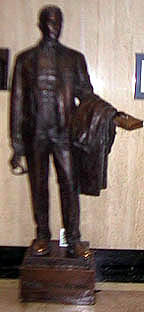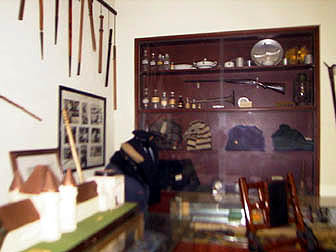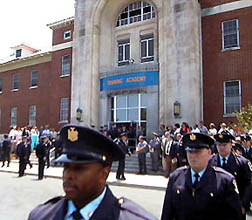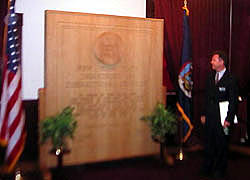|
Secured by a barred cell door with a wheellock used
at Clinton Prison more than 100 years ago, the collection includes:
- A logbook from the Asylum for Insane Criminals used from
1879-1904.

|
Thomas Mott Osborne statue in Academy lobby.
|
- 19th century striped uniforms worn by prison inmates.
- Punishment record for the years 1893‑1920 from the
State Prison for Women at Auburn.
- A replica of the electric chair used in Auburn for the
world's first electrocution in 1890, as well as the actual chair used in
Clinton before 1916.
- Scale model of Eastern New York Correctional Facility,
which in 1921 became the world's first institution for "defective
delinquents.
- Officers' uniforms, caps and badges from various periods.
- Elmira punishment paddle and antique restraint devices.
- Home-made weapons, drug paraphernalia and other
dangerous contraband confiscated from inmates.
Standing in the lobby is a statue of Thomas Mott Osborne, prison reformer and warden of Sing Sing in 1914-15 who initiated a controversial experiment in inmate self-government.
Photographs of prison life in the early 20'hcentury are in
the Museum and in the hallway off the lobby.
Overview of DOCS History
The New York State prison system had its beginnings in 1797
with a single prison (called Newgate after the infamous London
jail) located in what is now Greenwich Village. A second state prison opened 20 years later in Auburn (1817), and in 1825 a group of Auburn prisoners made the voyage across the Erie Canal and down the Hudson River to begin building Sing Sing. With the completion of Sing Sing in 1828, the state closed the overcrowded and already obsolete Newgate Prison.
It was at Auburn and Sing Sing that a system of prison
industry and discipline developed that would be embraced by the entire United States. Auburn was the first prison to house inmates in individual cells at night and release them during the day to work in factory settings, with the goal of self-sufficiency through the sale of goods on the open market.

|
Invited guest views Academy museum exibits.
|
Sing Sing in the 19th century featured brutal disciplinary
methods designed to maximize industrial efficiency. In both prisons, inmate
labor was contracted out to private manufacturers.
The Contract System of prison management was bitterly opposed, both on humanitarian grounds and as unfair competition to free workers. In 1894, an amendment to the New York State constitution prohibited the use of inmate labor for private gain, restricting the sale of prison goods to state and local government agencies. The State Use System, as it is called, was later adopted by most other states and by the federal prison system.
Auburn and Sing Sing became internationally famous,
attracting thousands of tourists (who paid a 25 cents admission fee) and officials from other states and European governments who wished to replicate the New York system. Among the visitors were Alexis de Tocqueville and Gustave de Beaumont, who were sent as representatives of the Republic of France in the early 1830s.
Over the following years, the state prison system gradually
grew in size and in diversity. In 1859, New York established the nation's first institution for insane criminals on the grounds of Auburn, later (1892) moving the Asylum for Insane Convicts to Fishkill as the Matteawan State Hospital.
The opening of an adult reformatory in Elmira in 1876
represented another first for the nation. Elmira Reformatory for males was
followed by the opening of women's reformatories at Hudson (1887), Albion
(1893) and Bedford Hills (1901).

|
Museum view from its doorway.
|
In 1921, New York established the nation's first institution for "defective delinquents" at what is now the Eastern New York
Correctional Facility in Napanoch. Ten years later, a similar institution for female defective delinquents was set up at the former women's reformatory at Albion.
1932 saw the establishment of a medium security prison at Wallkill, and the 1950s brought the state's first minimum security institutions in the form of forestry camps operated in conjunction with the State Department of Environmental Conservation.
Effective January 1, 1971, the state's complex of adult correctional facilities was reorganized as the Department of Correctional Services. Nine months later, the most severe prison riot in American history broke out at Attica Correctional Facility. A searching reexamination of correctional practices resulted in a heightened emphasis on educational and other rehabilitative programs including work release.
At about the same time, in the early 1970s, DOCS began to experience a steady and dramatic increase in the inmate population. From about 12,500 inmates in 1972, the census has grown to over 71,000 inmates in the year 2000. The inmates are held in 70 facilities across the state of varying security classifications and program specialties including shock incarceration and intensive drug and alcohol abuse treatment.
DOCS Training Academy
New York established its first formal training programs for prison personnel on the grounds of maximum security institutions in the
early 1930s.

|
Museum view from behind one of its electric chairs.
|
In 1936, the Department opened the Central Guard School for newly recruited officers at Wallkill Prison. Wartime restrictions and manpower shortages ended Guard School operations in 1942.
It was not until 1965 that centralized recruit training was resumed, this time on the grounds of Matteawan State Hospital (now Fishkill
Correctional Facility) in Beacon. The Beacon Academy offered a three-week training program for correction officers.
In 1973, the DOCS leased the Mater Christi Seminary from the
Diocese of Albany and established its current Training Academy there. The
property was purchased by New York State in 1987. Today, the Academy delivers approximately two million hours of professional training annually, in the form of initial instruction and ongoing in-service training, to the Department's 32,000 correction officers and civilian personnel.
The Corrections Museum was established in the Training Academy in 1981.
| 




